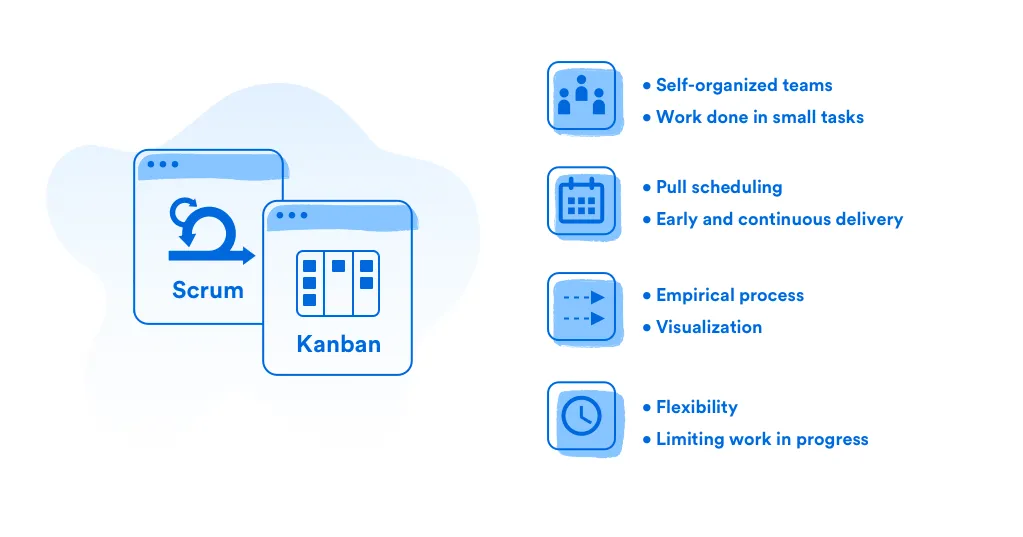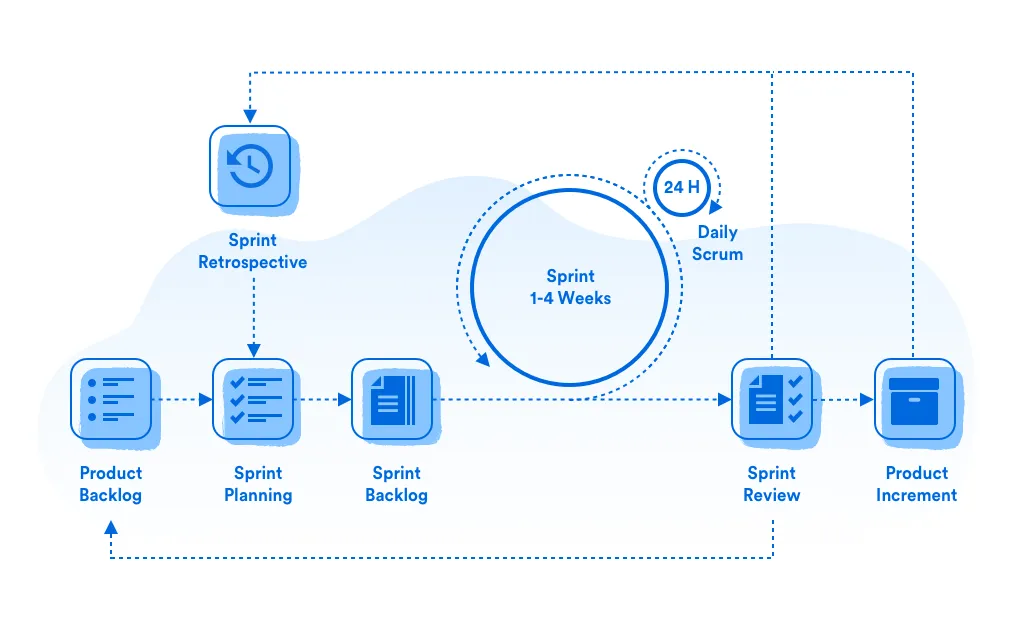Nowadays Kanban and Scrum have gained popularity and have taken the place of the previously popular waterfall method. These two frameworks have proven to be performance boosters by regulating communication and work efficiently.

What is Kanban?
This framework helps to visualize and monitor work. Kanban was founded in the 1950s by Taiichi Ohno and its main task was to improve manufacturing efficiency and to track the work visually with the help of a table and cards with tasks. The table is usually divided into three main columns visualizing progress. These columns are: to do, in progress, and done. Although if you want to fit the needs of a specific team, you can add more columns. Based on progress cards move from column to column.
Kanban is built on Agile principles. This framework is transparent, well balanced, and contributes greatly to the organization of the work of even a big team. Being very flexible, it can be easily adapted to the needs of a team, especially if the priorities quickly change.
What is Scrum?
The Scrum was founded by Hirotaka Takeuchi and Ikujiro Nonaka, who described it as an approach that should increase the speed and flexibility of a development process. It was fully implemented for the first time by Jeff Sutherland, Jeff McKenna, and John Scumniotales at the Easel Corporation, after a decade.
To split and optimize are the core principles of Scrum. Its work is based on the principle that everything which can be split into smaller units should be split. Kaizen should be taken into account. It means that the team should learn from their experience and strive to optimize the process.
Scrum is an Agile process. Scrum was successfully used and documented, and eventually became a foundation of Agile programming.
Scrum and Kanban Similarities

Kanban and Scrum have some things in common that are unique to the Agile development cycle. They are:
- Flexibility
The first principle of the Agile Manifesto is “Individuals and Interactions over Processes and Tools.” Both of them are quite flexible. But Kanban is less regulated.
- Limiting work in progress
These two frameworks set limits for the work in progress (WIP). On the one hand, Scrum measures velocity and on the other hand, it limits the number of tasks per sprint based on their estimation in story points. The tasks are to be developed during the sprint.
Kanban, in turn, limits work in progress by not having more than two tasks which are being done concurrently.
- Empirical process
Scrum and Kanban encourage continuous optimization and they are empirical. When you work with Kanban, you can't have more than two tasks in progress simultaneously. Although your team is able to work on four. That is why to optimize your workflow, you can adapt the framework.
- Pull scheduling
They both use a pull scheduling system. It is when there are a lot of tasks that need to be done. In Scrum, they are called a backlog. For every sprint, the team, together with the Product owner, pulls tasks from the backlog, prioritizes and estimates them, and adds them to the sprint.
As far as Kanban is concerned, product backlog is not a must-have, because priorities can change very quickly. It works the same for tasks. The "to-do" column serves as a so-called backlog. As the rule, the Kanban team and the client choose the principle of pulling tasks from the to-do column (e.g. newer/older or tasks with specific markers first, etc).
- Visualization
Scrum and Kanban use boards to visualize the progress of work. A Scrum board is erased for every new iteration, while a Kanban board with tasks is kept during the whole process of development.
- Early and continuous delivery
These two frameworks are concentrated on releasing potentially “shippable” pieces of work early and often. In Scrum, this happens at the end of each iteration, usually after a demo.
- Self-organized teams
Scrum and Kanban both have self-organized teams working on product development. This means that no one manages the team and every member is equal and contributes to the process.
- Breaking down the work into small, concrete tasks
Huge tasks are always broken down into smaller, which can be developed comparatively quickly. By the way, it is one of the factors that distinguishes Agile from waterfall methodology.
Difference Between Scrum and Kanban
Scrum and Kanban have many things in common, but at the same time, they have a lot of things that make them different from one another. If you understand these differences then it will help you choose the right framework for your project. Let's take the following criteria into account:
- roles and responsibilities within each framework
- measurement of productivity
- cadence
- release methodology
- types of meetings
- change philosophy
- key metrics
They will help us solve the Kanban vs. Scrum dilemma. Below you will learn which framework is better.
Features of Scrum Workflow

Roles and Responsibilities
Scrum has three predefined roles: Product Owner, Scrum Master, and Development Team. Some sources name Scrum Master and Development Team a Scrum Team.
- Product Owner sets the motion vector of the product development, defines priorities, and makes decisions.
- Scrum Master leads the process and removes impediments (if any).
- The development team implements tasks and produces software code.
Scrum doesn't limit the number of roles. You can have more roles if they contribute to the efficiency of the process.
Continue reading to learn which framework is better Scrum or Kanban